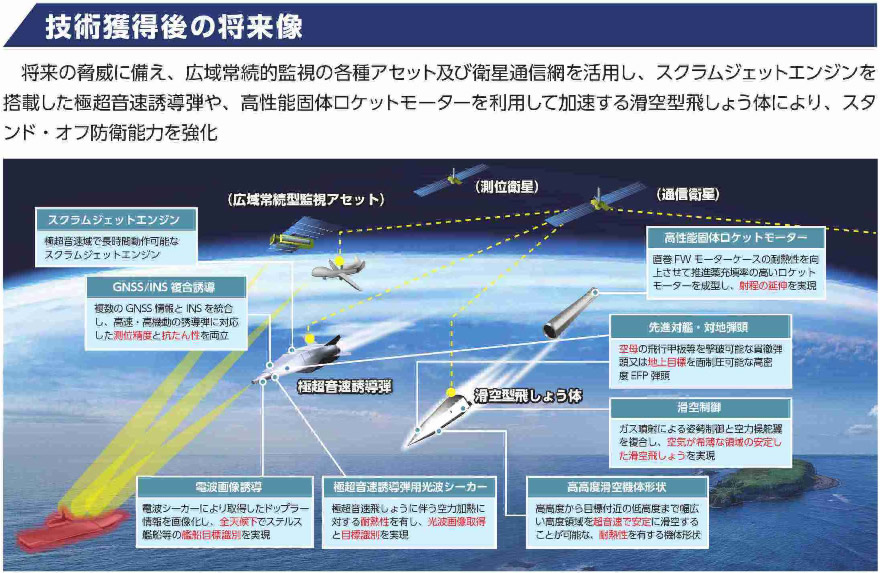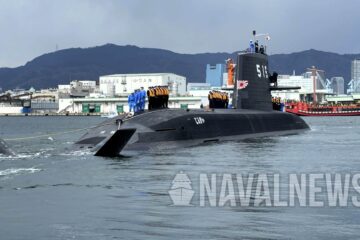Japan is preparing against a potential military invasion of its remote islands located in the East China Sea, including the Senkaku Islands. The HVGP is a new solution to defend against such invasion attempts.
The HVGP is launched from a mobile ground launcher. Once it reaches a certain altitude, the glider separates from the booster, and then glides at high altitudes at supersonic speeds while being guided by both satellites and inertial navigation system (INS). It then flies to the target point. The target is attacked from directly above at a 90° dive.
When the HVGP is separated from the booster, the warhead’s Radar Cross-Section (RCS) becomes extremely small, making it difficult to detect with radar. In addition, it will fly at high altitudes at supersonic speeds while following unpredictable trajectories, including high dives, thereby shortening the reaction time and making it difficult for enemy air defense systems to intercept.
Japan’s HVGP Block 1 and Block 2

The HVGP is planned to be developed and deployed in two phases (Block 1& Block 2) in order to achieve a short-term deployment:
- Block 1 is an early capability version. Its development period will be shortened by using existing missile technologies and by conducting tests of prototype with JGSDF unit.
- Block 2 is an enhanced capability version that makes use of the latest technology, which Japan’s Acquisition, Technology & Logistics Agency (ATLA) calls a “game changer”.
In HVGP Block 2, the warhead glides with the shape of a “wave-rider” that gains lift by the shock wave generated at the tip of the warhead. Due to this unique warhead shape, the range of Block 2 will be longer than that of Block 1.
U.S. Army LRHW

The U.S. Army is currently developing a Long Range Hypersonic Weapon (LRHW), a weapon similar to the HVGP, with the prototype expected to be scheduled for completion in fiscal year 2023. The development of the HVGP, especially Block 2, is expected to have technical and budgetary challenges, so the possibility of joint development between Japan and the United States is undeniable. In fact, the Japanese MOD’s official document on the HVGP states that development considerations will be made “with the possibility of international joint development”.
HVGP in anti-ship role

Interestingly, at a symposium held by ATLA in Tokyo late last year, an image of HVGP Block 2 attacking enemy aircraft carriers was released. In other words, it is planned that the Block 2 warhead will be equipped with a seeker to attack moving targets. Target acquisition of distant enemies and transmission of the targeting data to the HVGP is a challenge for now, but JSDF is currently working on establishing an information sharing system to conduct joint anti-ship warfare.Therefore, target information captured by the Japan Maritime Self-Defense Force (JMSDF) patrol aircraft and the Japan Air Self-Defense Force (JASDF) F-35 is expected to be used through data links.
According to a report by the Japanese newspaper Mainichi Shimbun on February 25, 2020, the range of the HVGP is about 500 km, but this is not an official figure, so the actual range is still unknown. However, logically, increasing the fuel capacity of the rocket to launch the HVGP will naturally extend the range of the warhead. Japan is currently under threat of ballistic missiles from North Korea and various types of missiles from China, and the HVGP may be a new solution to preemptively (before their launch) eliminate those threats from a safe distance.
Update 04/04/2020: Naval News an exclusive video from ATLA, the Acquisition, Technology & Logistics Agency of the Japanese M.O.D, showing the HVGP in an anti-ship role, targeting an aircraft carrier:






